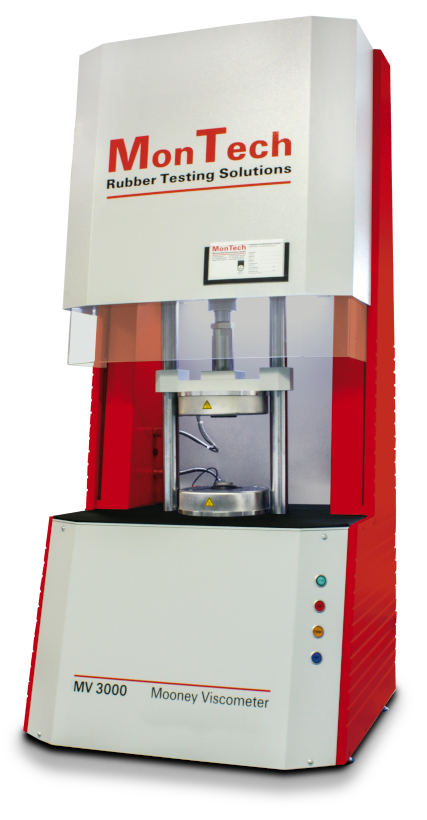MV 3000
Mooney Viscometer
The Mooney Viscometer built for intensive rubber production testing.
In a rubber mixing or heavy production settings, Mooney Viscometers need to withstand their environment, and user influence – for the long haul. The MV 3000 takes traditional Mooney technology to the next level by placing user ergonomics, the latest in industrial components, frame upgrades and software connectivity forward. With a 270° working area, achieving Mooney Viscosity, Mooney Scorch, and Stress Relaxations has never been easier.

The Mooney Motor That Drives Better

All MonTech Mooney Viscometers come with a brushless, speed controlled, and closed loop DC motor with gearhead. The advanced motor-style creates an unmatched improvement in reliability and creates a lower signal to noise ratio. In turn, the user will see greater data repeatability, an elimination of stepper ripples, and a smoother Mooney curve for the lifetime of the instrument.
- Standard Speed: 2 RPM
- Optional Variable Rotor Speed: 0.5 – 10 RPM
- Optional Variable Rotor Speed: 0.01 – 20 RPM


Frames Engineered
for Accuracy
The MV 3000’s frame plays a critical role in the long-term accuracy and stability of the data. The Mooney Viscometer 3000 series frame is built from high-strength aerospace grade aluminum and stainless steel. This includes an 80 mm thick baseplate and 20mm thick side panels. For ultimate parallelism we’ve included 50mm pull rods and an 80 mm crosshead. Together, this results in a superior frame stiffness improving repeatability, correlation, reduces damping challenges in high-frequency tests, all the while reducing the signal-to-noise ratio.
Fan-less Design: The frame’s design mitigates any form of potential heat build-up in the electronics cabinet. With no need for fans, and the frame’s sealed housing, carbon black contaminated electronic failures are a challenge of the past.
Technical Specifications
Standards | ISO 289:2005 |
Die Configuration / Rotor | According to international standards |
Force Measurement | In-line torqe transducer |
Closing Force | 11.5 kN |
Rotor Speed | 2.00 turns per minute (0.21 Radians / second) |
Stress Relaxation | According to ISO 289:2018, DIN 53523 Part 4 |
Torque Range | 0.01 to 230 MU |
Sample Volume | Two specimens having a combined volume of 25 cm3 |
Temperature Control System | Ambient to 232 °C, precision +/-0.03 °C, digital, |
Temperature Check System | Recordings of the temperature gradient on the screen, |
Calibration | Fully automatic by built-in calibration weights, software-guided |
Measured Data | Mooney - value (MU) |
Data Interface | Ethernet (10/100 MBit), USB (int.), CF card (int.), RS232 (opt.) |
Data Points | Over 3500 data points available, including: |
Pneumatics | min. 4.5 Bar / 60 psi |
Electrical | 200-240 V, 6 Amps, 47-63 Hz, Single phase |
Dimensions (H x W x D) | 59.84 in x 26.77 in x 23.62 in (152 cm x 68 cm x 60 cm) |
Instrument Options | - Instrument control panel with 5" touchscreen display and printer |
Request a Quote
Experts in Lab Equipment:
The fastest growing rubber testing equipment manufacturer.
13,000 instruments delivered since 1998.
Leaders in Innovation:
Labs evolve.
So should technology in the instruments.
The Team You Can Count On:
Speak to real people who understand your account.
Every time.
Dedicated Support:
Service, software and applications specialists are on standby.
And on your time zone.
Quality Forward:
ISO / IEC 17025 Accredited
ISO 9001:2015 Certified
